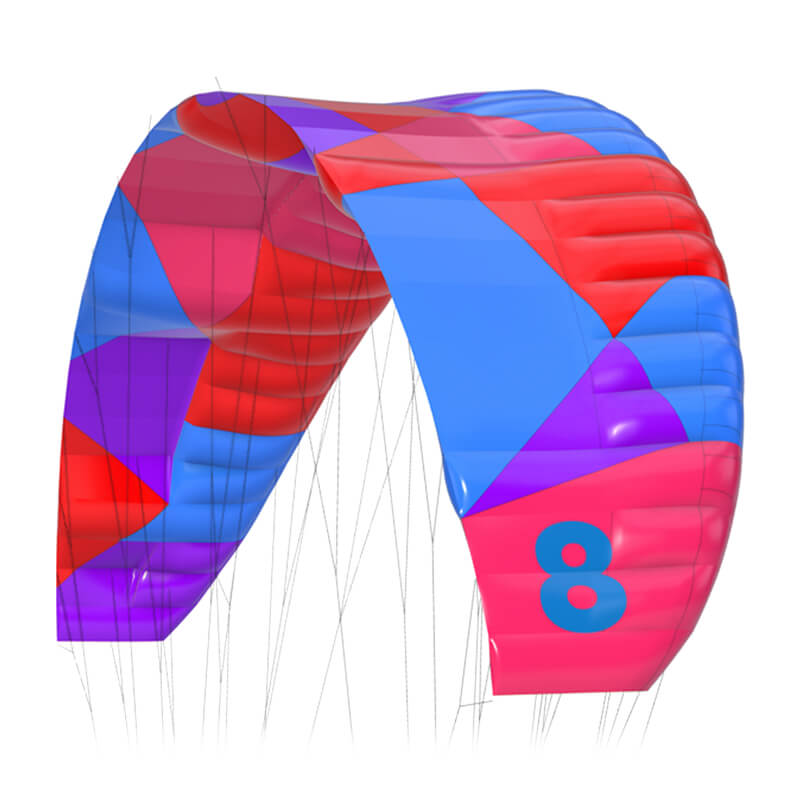When you purchase gear through links on our site, we may earn a small commission. Here’s why you can trust our tests and our affiliate partner.

As someone who has been around kiting for the last 15 years, the shapes and styles of the kites I have flown never cease to amaze me. The Airwave Alma came as somewhat of a surprise, to be honest, as I purposely avoided all things foil kite in the past. The fear of spending countless hours untangling bridles was one of the many false truths that kept me on the straight and narrow of leading-edge inflatable kites. That being said, the first thing that struck me about the Alma was its unconventional design, a hybrid single-skin configuration with closed cells up front and a single surface at the back, which sets it apart from anything I’ve encountered before. It positions itself perfectly as the middleman between the world of foil kites and the commercial world of LEIs. This unique kite is the brainchild of a dynamic collaboration between Airwave designer Tom Lolies and 11x World Champion Maxime Nocher. Their shared vision was clear from the outset – to create a kite that not only outperforms existing hybrid designs but also introduces cutting-edge technology. Through meticulous research, 3D modeling, and extensive prototyping, they transformed their vision into a reality by creating the Alma.
The Alma is a kite that promises to redefine the way we approach the sport. Adding in five inflatable spars for structure, you have a kite that strikes a harmonious balance between stability and versatility. To make it a little easier to understand, the five inflatable closed cells work just like the struts of an LEI kite, making the Alma a five-strut kite. The struts on the Alma are inflated by the ram-air intake ruts whilst the use of nylon rods allows the canopy to retain rigidity even in the strongest of conditions. Holding the Alma in my hands, I was struck by its weight, mostly the lack thereof. Crafted from standard-weight, durable fabrics, it’s a featherlight marvel, a staggering 20% lighter than the lightest tube kite on the market. This isn’t hard to imagine as it doesn’t have all the extra pieces – from the plastic molded valves to the bladders – that come with LEIs. On the water, the Alma’s incredibly light construction translated into a foiling dream; the kite has an unmatched amount of float when it comes to foiling downwind. On a traditional foil kite, you might run into the common nightmare of its tips collapsing into the bridles when performing these downwind runs but with the Alma, it’s an impossibility.
This reduction in weight not only allows the kite to float downwind with ease but it translates to an agile and nimble ride, particularly in disciplines like foiling, wave riding and even Big Air. Alma’s structural design allows for a serious amount of hangtime, a testament to its revolutionary nature. This is thanks to some clever engineering, a high-aspect ratio, the radical arc, and its five closed cells stiffened with high modulus nylon wire to ensure a stable, flutter-free canopy. These design choices were created in the pursuit of eliminating all issues relating to common trailing edge flutters that occur in foil kites. Not only did they achieve this, they enhanced the overall stability even in some of the most turbulent conditions.
Flying the Alma was somewhat of an intuitive experience; the kite has the characteristics of a standard LEI kite, yet the benefits of a foil kite at the same time. Even Alma’s arcing turn characteristic is similar to that of an LEI kite, allowing you to generate power as you drive it through the window. Once you have generated the initial power, the foil characteristics of the kite take over. The power is transferred to some impressive bar control, much like that on a race kite. The Alma has a unique ability to adjust the flying profile by changing the throw on the bar, enabling precise control over not only the power delivery but the exact angle the kite flies in the window. We noticed that when we pulled the bar in, the kite would generate more drag, slowing down the kite significantly whilst increasing the angle of attack to produce the maximum amount of lift or power. Most foil kites would stall if the bar was fully sheeted in without enough apparent wind, whilst the Alma is incredibly forgiving allowing it to be a user-friendly option. Another great user-friendly quality is its ability to dump power by pushing the bar out, a very similar experience to that of an LEI kite, allowing you to feel safe in the strongest conditions.
One of the most remarkable aspects of the Alma is its exceptional ability to cross disciplines, from drifting down the line in search of waves on a surfboard, to launching yourself in the air with a twintip. The Alma was designed to be a multi-discipline kite, let’s call it the do-it-all all kite. I come from a massive wave-riding background and couldn’t help myself from taking the Alma out into the surf. I was impressed by its ability to maintain shape and stability even as I dug myself into some heavy bottom turns. The ability to dump power whilst retaining line tension was something I had only previously experienced on some of the most highly tuned wave kites and wasn’t something I expected out of the Alma.
Rumors are that Maxime Desjardin has his eyes set on the first-ever double loop on a foil kite, so who knows what the future holds for Airwave and the Alma, but on this evidence we are excited.
